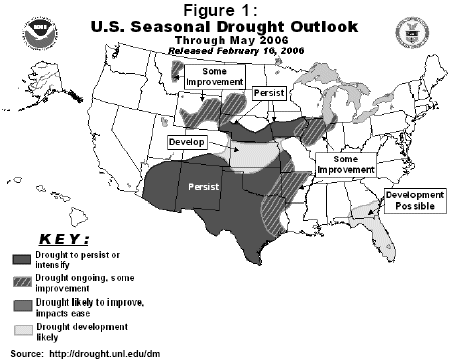AG-ECO NEWS
Vol. 22, Issue 06, March 10, 2006
Jose G. Peña
Extension Economist-Management
Driest Winter on Record;
Start Planning to Survive the Drought
Ranchers have reduced their herds. Pastures, ranges, trees, plants, home lawns and wildlife are under stress and the region is under a significantly increased risk of brush fires. We can expect an increased incidence of wildlife road-kill this spring as wildlife venture out to graze on road side grasses which escape livestock grazing and normally gain some moisture benefit from black-top run-off. Even if it rains now, it appears unlikely that sufficient forage will be produced, before the typical mid-summer dormancy in July-August, to sustain livestock without affecting wildlife. The agricultural sector should initiate immediate plans to help cope with a continuing dry period.
The moisture situation is almost the opposite of a year ago at this time when winter/spring ‘04/’05 rainfall was excellent and the soil profile was full as spring began. Now, the soil profile is completely dry. Some soils are cracking from lack of moisture and there may not be sufficient top soil moisture from the recent rain to kick-start spring activities.
This dry spring weather is causing water usage at an accelerated rate. In terms of the Edwards Aquifer, while the water levels in test wells in Uvalde, Medina and Bexar counties are significantly below the water levels of a year ago at this same time, water levels remain at, or slightly above, the historical monthly average for March. If the dry-spell continues, we can expect water rationing soon.

Livestock/wildlife
Water is no doubt the most important of all nutrients for all living things, but especially for livestock. Since ruminants, such as cattle and deer, are able to store large amounts of water in their stomachs, they are better adapted in surviving droughts than monogastrics, such as hogs. However, the absence of drinking water forces a liquidation decision.
After the longest cattle inventory cycle on record, herd rebuilding is on its second year. USDA’s January 1, 2006 cattle report indicated that the inventory of all cattle and calves in Texas at 14.1 million head was up 2.9 percent from an inventory of 13.7 million head on January 1, 2005. Herd rebuilding in Texas may actually be slower than USDA’s January 1, 2006 inventory report indicates. This dry spell may require further stocking adjustments.
Assuming that sufficient amount of drinking water is available, the livestock management decisions during drought will be driven by forage availability. As a result, the first step in a drought livestock management plan is to reduce the herd size based on the forage available, taking into account the wildlife and its economic value. From an economic point of view, supplemental feeding for livestock and wildlife should only be provided to facilitate use of available forage. According to Dr. Rick Machen, Associate Professor and Extension Livestock Specialist, a 1000 lb. cow requires 20-30 lbs. of dry forage, or 2 to 3 percent of her body weight, per day. Beef cattle, sheep and goat production systems operate on a forage foundation. Forage is most economically grown in pastures. Hay is a substitute for pasture forages and given the current supply shortage and premium prices, hay feeding will not continue much longer. When forage is extremely short, supplementation in any form for extended periods of time is usually uneconomical.
The outlook for deer hunters next fall may not be very good if we continue to have dry weather. Although brush, on which deer rely for summer forage, is deep rooted and will green-up sooner than herbaceous forage, rainfall is still needed to maintain leaf production. If we do not get any decent spring/summer rains, we can only hope for a good crop of mesquite beans to help the deer this summer.
